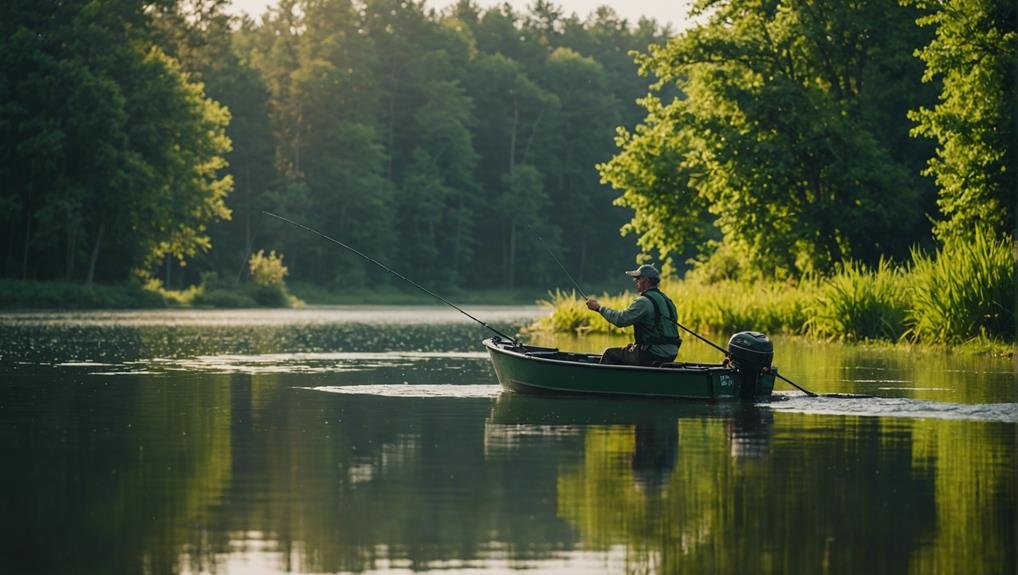To start your journey into bass fishing, you’ll want to focus on the best times to fish, which include low-light conditions like sunrise, sunset, and nighttime during warmer months. You’ll also need to identify prime locations with abundant cover, such as stumps, timber, and grass beds where bass typically hide and ambush prey. Understanding these basics will set you on the right path, but there’s much more to explore. How do you choose the right lures or adapt your gear for different conditions? Let’s break down these essential techniques and strategies to elevate your bass fishing experience.
Key Takeaways
- Fish during low light conditions like sunrise, sunset, and nighttime, especially in warmer months.
- Target areas with abundant cover include stumps, timber, and grass beds.
- Use crankbaits to cover large areas quickly and match diving depth with line poundage.
- Adapt your lure choice based on water clarity and conditions.
- Understand bass behavior and seasonal patterns to locate them effectively.
Best Times to Fish
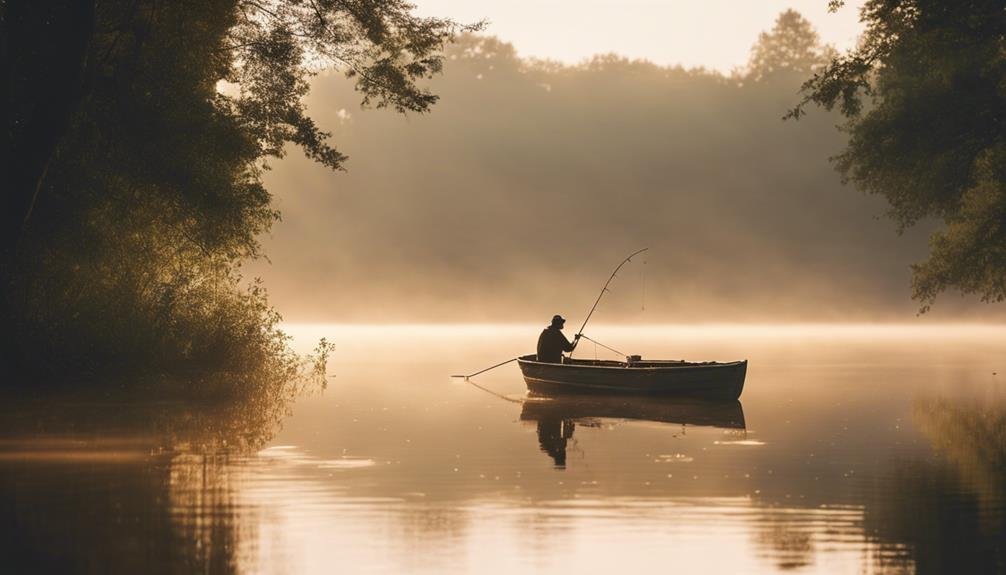
The best times to fish for bass are during low light conditions like sunrise, sunset, and nighttime in warmer months. You’ll find that early morning and late afternoon offer prime bass fishing opportunities. These times are perfect because bass are more likely to venture out to feed when the sun isn’t high in the sky.
Fishing at night can also be incredibly productive, especially during warmer periods when water temperatures are ideal. Peak times for bass fishing often occur in spring and early summer when water temperatures range from 60-75 degrees Fahrenheit. During these months, bass are highly active and ready to strike.
The ideal water temperatures and low light conditions make these periods particularly effective for catching bass.
Finding Optimal Locations
When searching for prime bass fishing locations, focus on areas with abundant cover, like stumps, timber, and grass beds. Bass are naturally drawn to these habitats because they offer excellent ambush points for prey. Look for spots where water conditions or vegetation change, as these shifts often attract bass.
Areas with different types of cover provide bass with the perfect hiding places and hunting grounds.
In ponds, streams, rivers, lakes, and reservoirs, bass prefer locations offering cover and feeding opportunities. Docks and hard-to-reach spots can be particularly productive, as bass use them to hide and wait for unsuspecting prey. Fishing near these structures can greatly increase your chances of a catch.
Additionally, in river systems, bass are often found in current positions where the flow of water brings food directly to them. Understanding the relationship between bass behavior and their preferred habitats will help you identify these ideal locations.
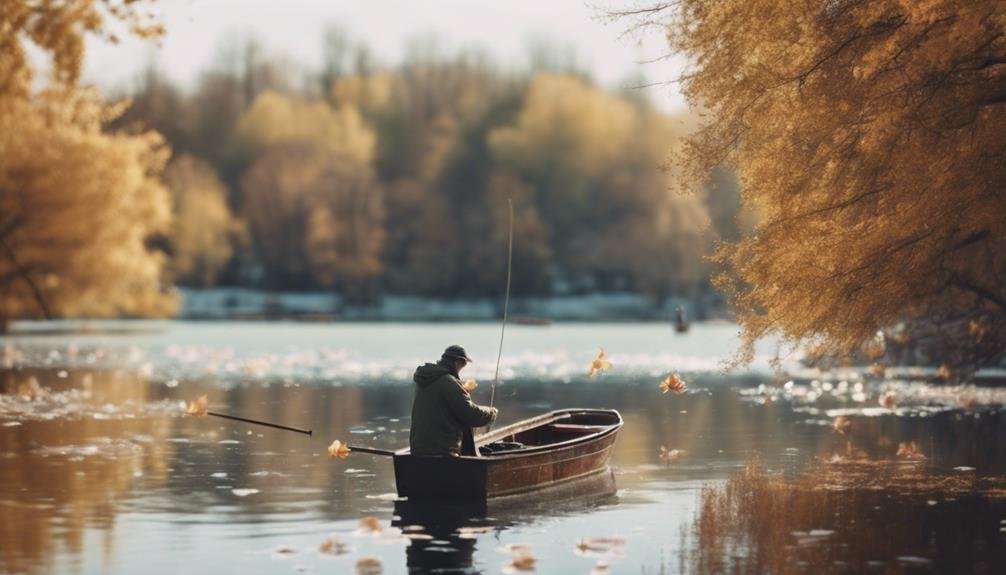
Understanding seasonal bass behavior is essential for adapting your fishing strategies throughout the year. As water temperature rises to 60-75 degrees in spring, bass move to shallow water to prepare spawning beds. Spring bass are more active and aggressive, making it an excellent time to catch big fish. You’ll want to cover the ground to locate these spawning beds.
| Season | Key Behavior |
|---|---|
| Spring | Move to shallow water for spawning |
| Summer | Seek deeper water and shade to escape heat |
| Fall | Feed aggressively near structure and cover |
| Winter | Become lethargic and stay in deeper water |
| Year-Round | Behavior influenced by water temperature |
In summer, bass seeks cooler, deeper water and shade to escape the heat. They often hang around structures where they can find cover. When fall arrives, bass feeds aggressively to prepare for winter, often near structures and cover. This season is perfect for catching active bass. During winter, bass become lethargic due to cold water temperatures and prefer deeper water. Slow down your presentation because they’re less likely to chase fast-moving baits.
Choosing the Right Lures
Adapting your fishing strategies to seasonal bass behavior is only half the battle; choosing the right lures can make or break your success on the water.
Crankbaits are essential for covering large areas quickly. You’ll need to decide between lipless crankbaits and lipped crankbaits based on the water depth you’re targeting. Lipless crankbaits are perfect for shallow waters, while lipped crankbaits are better for deeper environments.
Consider your crankbait’s diving depth and match it with the appropriate line poundage. For example, heavier lines will limit the diving depth, making them suitable for shallower areas. On the other hand, lighter lines allow crankbaits to reach greater depths, which is ideal for deeper conditions.
The water conditions you’re fishing in also play an important role. Clear water might demand more natural-looking lures, while murky water could require brighter, more noticeable options. Different lures have specific uses, so having a variety on hand helps you adapt to changing conditions and water depth.
Selecting Fishing Gear
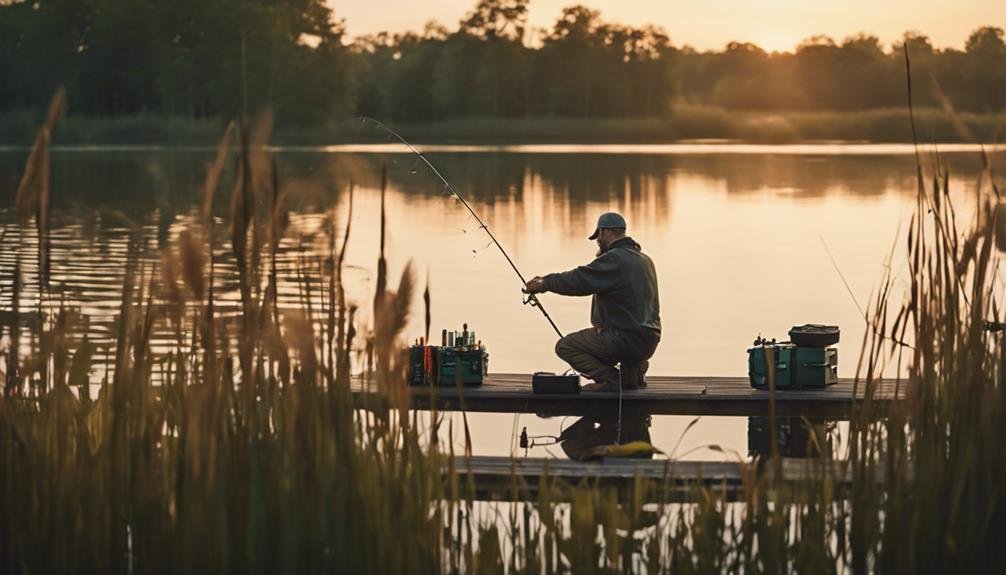
A solid foundation for successful bass fishing starts with selecting the right gear. First, choose a medium-heavy spinning rod paired with a spinning reel. This setup provides excellent hook-setting power, essential for reeling in that strong bass.
Opt for the 6-8 pound test Seaguar Invizx line; it’s a fluorocarbon line that offers increased sensitivity and invisibility underwater, giving you a significant advantage.
When it comes to lures, plastic worms are a must-have in your tackle box. They’re versatile and attract bass effectively in various conditions. For heavier cover situations, consider switching to a braided line for its strength and durability.
Another vital component is a baitcasting reel. It should have a high gear ratio, allowing more efficient lure retrieval. This is particularly useful on bass boats, which cover larger water areas.
Remember to consider the rod length based on your casting distance needs and the line weight according to the type and depth of lures you’re using.
With the right gear, you’ll be well-prepared to tackle any bass fishing challenge that comes your way.
Casting Techniques
Mastering casting techniques is crucial for increasing your bass fishing success. Start by holding your rod at the 1 o’clock position. This helps you achieve accurate casts with good distance. Use the rod’s pendulum motion to generate power. When you release the line, do it with a smooth and controlled motion to avoid backlash and guarantee a clean presentation.
Adjust your casting angle and force based on the wind direction and strength. For example, casting into the wind requires more force and a lower angle, while casting with the wind allows for a higher angle and less force. Incorporating different casting styles like sidearm, overhand, and underhand will help you adapt to various fishing scenarios and obstacles.
Here’s a quick reference table:
| Casting Tips | Description |
|---|---|
| Rod Position | Hold at 1 o’clock for accuracy and distance |
| Pendulum Motion | Generates power for longer casts |
| Smooth Release | It avoids backlash, guarantees a clean presentation |
| Wind Adjustment | Modify angle and force based on wind direction |
Retrieval Methods
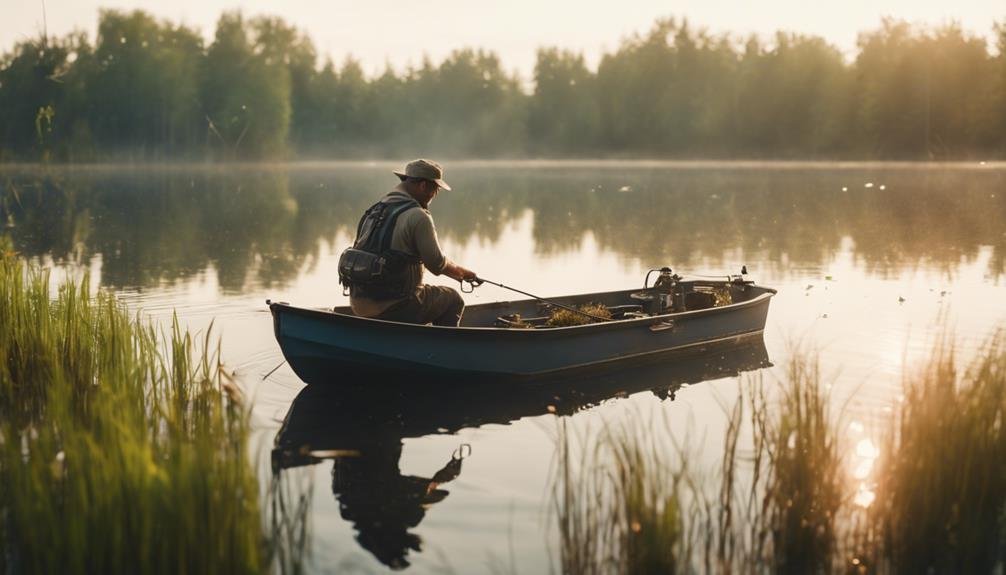
Experiment with different retrieval speeds to mimic injured or fleeing prey to catch more bass. This technique can trigger a bass strike by creating an illusion of easy prey.
Here are some effective retrieval methods to explore:
- Stop-and-Go Retrieval: This method involves reeling in your lure, then stopping briefly before starting again. It mimics the unpredictable movement of injured prey and can entice bass to strike.
- Steady Retrieval: Maintain a consistent speed when reeling in. This method works well in clear water where bass can see the lure from a distance and follow it before striking.
- Erratic Retrieval: Incorporate quick jerks and pauses to make your lure move unpredictably. This erratic retrieval can provoke a reaction strike, especially in murky water where bass rely more on vibrations and sudden movements.
- Varying Depths and Angles: Change the depth and angle of your retrieval to cover more water and adapt to bass behavior. This approach increases your chances of encountering bass at different levels.
Adjust your technique based on water clarity, temperature, and the natural lure you’re using.
Using Fishing Boats
While experimenting with different retrieval methods enhances your chances of catching bass, using the right fishing boat can greatly elevate your fishing experience. Bass boats are specifically designed for largemouth bass fishing and feature essentials like live wells, casting decks, and rolling motors. These features allow you to maneuver in shallow waters and keep your catch fresh.
If you’re looking for versatility, Fish-and-Ski boats offer a great option. They’re perfect for bass fishing and recreational activities like water skiing or tubing, making them ideal for family outings.
For those who prefer a more flexible approach, all-purpose fishing boats are suitable for various fishing endeavors, including bass fishing in different bodies of water. These boats can handle deep diving and shallow fishing environments, ensuring you’re prepared for any situation.
Use Boat Finder tools to find the perfect boat that meets your needs. They help identify the ideal bass fishing boat, whether you’re looking for budget-friendly options or high-end models fully equipped with the latest technology. Choosing the right ship will enhance your ability to fish for bass and make your fishing enjoyable and productive.
Understanding Bass Habits
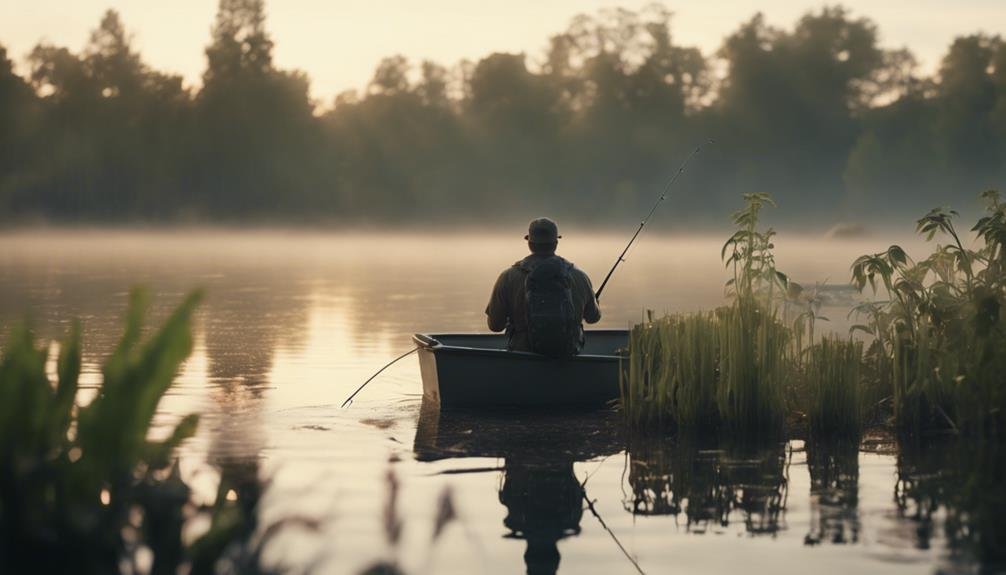
Understanding bass habits is essential for any angler aiming to increase their catch rate and overall fishing success. Bass are most active in water temperatures between 60 and 75 degrees Fahrenheit, so you’ll want to focus your efforts during these conditions.
Here’s a breakdown of key habits and patterns to help you out:
- Spawning Cycles: Bass spawn in the spring when water temperatures rise above 65 degrees. During this period, they’re often found in shallow waters, making it a good option for catching bass.
- Summer Behavior: In the summer, bass always seeks cooler, deeper waters during the day’s heat but can be found around cover, such as submerged structures or vegetation, early in the morning or late in the afternoon.
- Habitat: Understanding bass habitat is critical. They prefer areas with ample cover, such as weed beds, fallen trees, and rocky points. These spots offer protection and ambush points for feeding.
- Seasonal Movements: Bass exhibit different movement patterns in summer, fall, and winter. They move to deeper waters in colder months, so adjusting your fishing technique and location is essential.
Conclusion
To bass fish successfully, focus on fishing during low light conditions, target areas with ample cover, and adjust your gear and lures based on the environment.
Understanding seasonal bass behavior and employing effective casting and retrieval techniques will enhance your chances. Whether fishing from shore or a boat, knowing bass habits and using the right strategies will lead to a rewarding experience.
Get out there, apply these tips, and enjoy your bass fishing adventures!
FAQs
What are the best techniques for bass fishing?
Effective techniques for bass fishing include casting crankbaits, using soft plastic worms with a Texas or Carolina rig, and employing topwater lures in the early morning or late evening. Varying the retrieval speed and jigging can also help attract bass.
What type of gear do I need for bass fishing?
For bass fishing, you’ll need a medium to heavy action rod, a reel with a good drag system, and a strong fishing line (10-20 lb test). Essential lures include crankbaits, spinnerbaits, soft plastics, and jigs. Additional gear like a tackle box, pliers, and a landing net will also be helpful.
Where are the best places to fish for bass?
The best places to fish for bass include lakes, rivers, and ponds with abundant vegetation, submerged structures, and drop-offs. Look for covered areas like weed beds, lily pads, fallen trees, and docks. Bass often hide in these spots to ambush prey, making them prime locations for fishing.
